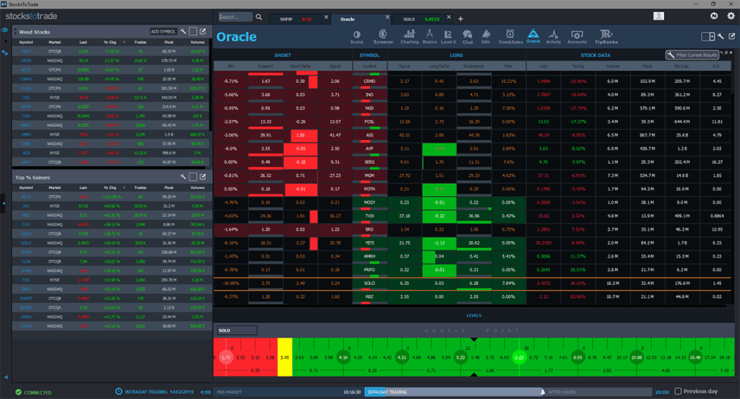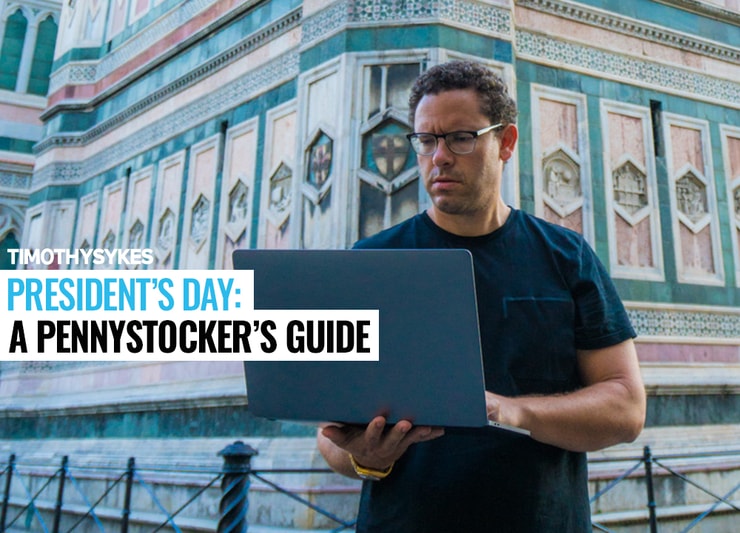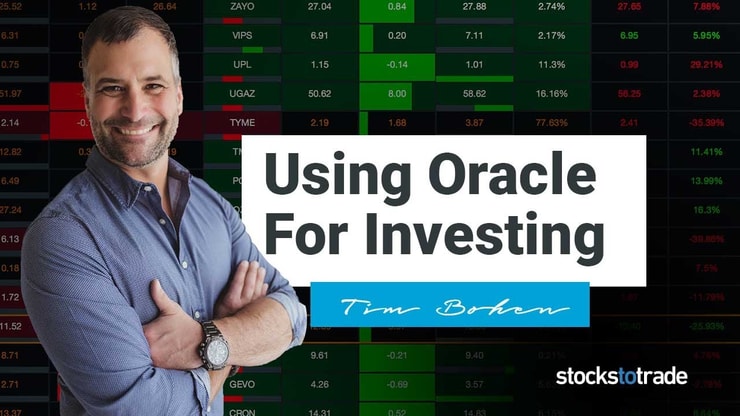Depending on where you’re from, today might be celebrated under different names. While most of us now refer to the third Monday in February as President’s Day, officially it’s still a celebration of George Washington’s Birthday. Go figure.
In today’s post, I’ll share a little about the holiday and how it has affected the stock market historically. Then I’ll give you my opinion on what you should be doing today — especially if you’re still new to trading. (Hint: Apply for the Trading Challenge.)
Table of Contents
What Is President’s Day?
President’s Day is a federal holiday in celebration of Washington’s Birthday. Back in 1879, an Act of Congress made Washington’s Birthday a holiday for federal offices in Washington. The holiday expanded to include all federal offices in 1885. Until 1971, Washington’s Birthday was celebrated on February 22 — his birthday — each year.
In 1971 Congress got involved again and passed a law making most federal holidays occur on a Monday. At the same time, they moved the celebration of Washington’s Birthday to the 3rd Monday in February. Which means, if you do the math, it never occurs on Washington’s actual birthday anymore. Sorry, George.
Stock Markets Closed On President’s Day
In the U.S., President’s Day is an official stock and bond market holiday. Other markets around the world are open as usual. Also, forex markets and foreign futures markets are open but trading is thin because the banks are closed and brokers take the day off. Not the best time to trade those markets.
Study Up: The Truth About Success
“Every expert was once a beginner.”
— Rutherford B. Hayes, 19th President of the United States
My opinion on how to spend stock market holidays …
… study, study, study.
And this isn’t just about trading — it applies to anything in life you want to do well.
Back in high school, I became obsessed with winning and training hard as a tennis player. I practiced like crazy, but lost in the finals of the Class L State High School Tennis Championships as a junior — in a third set tiebreaker, no less! I was determined to win it all the next year. I was on a mission.
Truth be told, I overtrained because I ended up with an injury requiring surgery. That was the end of my tennis career. But what I hope you understand from my story is that if you really want something you put in the effort.
Notice I didn’t guarantee your success. I can’t guarantee you’ll become a successful trader if you apply for the Trading Challenge. But I can tell you that it’s a solid program that teaches you what you need to know. It’s your job to put in the effort. All my top students are part of the Trading Challenge.
History of President’s Day

2025 Millionaire Media, LLCPresident’s Day is an idea that’s been floating around since the 1950s.
Because many states recognized Lincoln’s (February 12) and Washington’s birthdays, there was a push for a combined holiday. Beginning in 1951 there was a “President’s Day National Committee” formed to promote the idea.
President’s Day, as we know it, became the popular term in the ‘80s with a push from advertisers. Seems they’re always looking for a reason to create a sale or a new promotion.
Now here we are, left with an official celebration of Washington’s birthday and the unofficial name we all use: President’s Day. And it’s meant to celebrate all presidents, past and present. Regardless of which presidents you like or dislike, it’s their day. Cheers!
OK, now let’s get back to what we’re really here for: to learn something about trading and the markets.
More Breaking News
How Does the President’s Day Holiday Affect the Stock Market?
I can’t remember the exact statistic but something like three-quarters of stocks follow the overall market trend on any given day. If the markets are up, then most stocks are up. And vice versa.
So what happens in the stock market around President’s Day? First let’s take a look at holiday trading in general.
Trading the Three Days Before and After Holidays
According to the “Stock Trader’s Almanac,” in the past stock indexes tended to rise before a holiday and fall in post-holiday sell-offs. But in recent years each holiday has taken on its own character — so the old idea of buying into the holiday doesn’t necessarily pay off.
President’s Day Is the Least Bullish of Holidays
Also from the “Stock Trader’s Almanac”: President’s Day is the least bullish of the formal holidays. Their statistics cover the day before and the three days after the holiday. On average, the four major indexes (S&P500, DJIA, NASDAQ, Russell 2K) have been down on the last day of trading before President’s Day between 1980 and 2017.
And on the days following President’s Day? On average, all four major indexes have been down the three trading days after President’s Day over the same period.
Post President’s Day Stock Market Projections
Did you notice I didn’t say the four indexes were down every year? That’s important. This isn’t an exact science. If it was that easy we could all take most of the year off. Then we could short sell index funds on those days and make a killing.
But what does all this mean for you as a trader? To be clear, it might not mean anything. But it’s good to know the history and seasonal cycles of the markets.
“But, why?” you ask…
Because for every block of shares you buy, someone is selling. And for every block of shares you sell, someone is buying. The more you know about the markets — and market psychology — the better. Be smarter than the next trader. At the very least be more knowledgeable. Develop the right trading psychology.
So what should you be doing today? Instead of taking the day off completely, why not put in a long day of study? Prepare for the rest of the week. Watch some of the Trading Challenge videos or read “The Complete Penny Stock Course.”
“Nothing can stop the man with the right mental attitude from achieving his goal; nothing on earth can help the man with the wrong mental attitude.”
— Thomas Jefferson, 3rd President of the United States
Know Your Trading Strategy
I don’t care what day of the year it is. Or whether you trade the U.S. markets or foreign markets. It doesn’t matter if you trade penny stocks — my top choice — or options. It doesn’t matter what you trade. You need to go in with a strategy.
If you can’t clearly define your trading strategy … and explain it in simple terms to someone who asks … then you better step back and study some more. No degenerate gambler BS. Don’t trade blindly. Know your strategy and follow it.
If you have no idea about trading strategies I suggest you start with my YouTube channel, the book I recommended above, and my Twitter feed. You’ll start to get ideas. If you want to know my favorite strategy right now — my favorite pattern — it’s dip-buys into morning panics.
I’ve had a lot of successful morning panic trades in the last few weeks, including a sweet $4,092 win on SHMP on February 12.** My results aren’t typical. This isn’t the only pattern, either. There are several patterns potentially in play in the current market. First green days for longs. First red days for shorts. Morning panics. Supernovas.
It’s been a great couple of weeks of trading!
Use a Stock Screener
New followers often ask me how I find the stocks I trade. If you’ve been following for a while you might know this but it doesn’t hurt to review. To find the stocks I trade, I use a stock screener.
I look for several criteria but almost always start with these …
- First, I look for biggest percent gainers for the day. At the end of the trading day or during pre-market hours, depending on where I am in the world, I screen for those stocks.
- Then I look to see how the stock has traded in the past and whether there is a news catalyst driving the price movement. Then I do some research to see what the news is and try to form an idea about whether the stock should be on my watchlist.
- I also look for volatility and volume. I look at float — the number of shares available to trade — to determine how that might affect supply and demand should the stock keep moving.
Does that sound like a complex process? Well, it used to be. I had to use upward of a dozen different websites to get the information I needed to start developing a plan. Now?
Now I use …
StocksToTrade
I keep going on and on about StocksToTrade. I use it every day. I can do everything I need to do to screen stocks, do research, and develop a trading plan right inside StocksToTrade.
This time I’m going to focus on one feature of StocksToTrade that will make your life easier. It’s called Oracle. What is it?
Oracle is the proprietary tool built into StocksToTrade which gives you a ready-made watchlist. Based on volatility and certain other criteria, Oracle gives you a list of 15 stocks to watch (give or take a few).

But it does more than that. Oracle provides contingencies for short and long selling. It lays out possible trading plans for trading either short or long. That doesn’t mean you should trade every stock Oracle has highlighted, but it gives you a place to start looking.
What criteria does Oracle screen for? Good question. There are a few. Volatility is one. Float is another — in particular, the potential to rotate the float. In case you aren’t sure what that means, it’s part of supply and demand. Float is the number of freely tradable shares.
If a stock trades heavily early in the day … and prices are moving … it’s possible the entire float could trade in one day. That’s called Rotating the Float. So that’s one thing Oracle looks for, the potential to do that.
Oracle also looks at some other key indicators like Fibonacci and creates a trading plan based on what it sees. Which leads me to my next point about what you should be doing on President’s Day …
Create a Trading Plan
Every trade you make — every single one — should start with a plan. Especially if you have less than a decade of experience. But even after that, you should still use them for every trade. Why? Because trading plans are incredibly useful.
I often get asked what should be included in a trading plan.
I hope you’ve figured out that your watchlist, in many ways, represents your trading plan. At least it’s the start of your plan. The watchlist is kind of like saying “Here are the opportunities available to me.” Then, you start to go deeper and decide what you would do with each of those opportunities.
This is one of the reasons you don’t need a massive watchlist. Ten stocks are plenty, and maybe even too many at first. So while everyone else is taking President’s Day off, put together a watchlist (mine looks like this) and create a trading plan.
If you have zero ideas about finding stocks to watch at this point, re-read this article because I’ve given a lot of tips.
Also, sign up for the 7-day trial on StocksToTrade. If you’ve been at this for a while, you’ll be amazed at all the features. And if you’re new, it’s an ideal way to start.
Preparation Is Key
Let’s review a little since today is a study day. So far, I’ve mentioned this …
- Know your strategy
- Use a stock screener
- Make a trading plan
That’s all preparation. It’s what we do to try and protect ourselves and get ahead.
The way to prepare?
Study. Study like crazy. Study like it’s the most important thing you can do.
Does this mean you should never take time off to rest? No. You need rest. But build the habit of study and a strong work ethic. Then when you rest it will be with a peace of mind rather than a false hope for change.
Keep Seeking Knowledge
No matter what …
Never. Stop. Learning.
Life is an incredible journey if you have the right attitude and keep soaking up knowledge. What’s a great way to do that when it comes to trading?
Trading Challenge
The Trading Challenge is an immersion into penny stock trading. If you’re accepted into the Challenge, you get access to my live Wednesday morning webinar. I also do a Wednesday evening live lesson and Q&A.
On Thursdays, there’s live trading with one of my ace students, Mark Croock. Twice a month, my all-time top student Tim Grittani gives webinars. And yet another of my top students, Michael Goode, gives a monthly bonus training.
Plus you get access to the Challenge team chat room, a full year of Pennystocking Silver over on Profit.ly … full access the the DVD library …
It goes on and on.
Look, I don’t want to be ‘salesy’ — but I want you to step up and follow your dreams and goals. Do whatever you can to make your life as incredible as possible. If it isn’t the Trading Challenge, do SOMETHING today that moves your further ahead on your goal path.
Look, the Trading Challenge isn’t for everyone. But it might be right for you. If you’re willing to put in the effort, study, apply rules, and learn as much as you can, it’s a great educational opportunity.
Bottom Line
President’s Day is an official stock market holiday. Which makes it a great day for you to study.
Figure out what you want to learn (penny stock trading, right?), make a plan to study, and execute your plan. Set some goals — say, what you want to learn in the next 12 months. Then break it down into 90-day chunks. Then monthly and weekly goals. Then get to work!
Finally, a little tough love from the nation’s 26th President …
“If you could kick the person in the pants responsible for most of your trouble, you wouldn’t sit for a month.”
— Theodore Roosevelt, 26th President of the United States
Are you a trader? How will you apply the ideas in this post? What do you do every day to prepare for trading? New student? What did you learn in this post that you can use today? Comment below!










Leave a reply